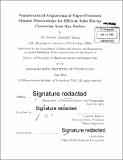Nanostructural engineering of vapor-processed organic photovoltaics for efficient solar energy conversion from any Surface
Author(s)
Macko, Jill Annette (Jill Annette Rowehl)
DownloadFull printable version (22.55Mb)
Other Contributors
Massachusetts Institute of Technology. Department of Materials Science and Engineering.
Advisor
Vladimir Bulovic.
Terms of use
Metadata
Show full item recordAbstract
More than two billion people in the world have little or no access to electricity. To be empowered they need robust and lightweightrenewable energy conversion technologies that can be easily transported with high yield from our manufacturing centers to their (often) rural homes. Few conventional photovoltaic technologies are robust enough to fill this need, however organic photovoltaics (OPVs) are ideal candidates due to their potential to be ultra-lightweight and flexible. However, this promising technology is currently limited by its relatively low power conversion efficiencies. This doctoral dissertation seeks to speed the eming of this promising technology. As a proof of concept for the accessibility and ultra-lightweight of OPVs, we integrate vapor-processed carbon-based electrodes and sub-30nm-thin encapsulations in organic photovoltaics, leading to the demonstration of monolithic, robust solar cell arrays as well as the first ever solar cells fabricated directly on paper. Furthermore, we have developed and advanced two unconventional approaches to enhancing power conversion efficiency via conventional methods: (1) optimization of multijunction efficiency via computational optical interference modeling and subcell photocurrent balance quantization and control, and (2) novel implementation of conventional vapor processing methods in the formation of molecular semiconductor crystals. This work has confirmed the potential of carbon-based materials to enable robust, ultra-lightweight, efficient solar arrays, thus advancing their capacity to empower our brothers and sisters even at the ends of the earth.
Description
Thesis: Ph. D., Massachusetts Institute of Technology, Department of Materials Science and Engineering, 2014. Cataloged from PDF version of thesis. Includes bibliographical references (pages 147-164).
Date issued
2014Department
Massachusetts Institute of Technology. Department of Materials Science and EngineeringPublisher
Massachusetts Institute of Technology
Keywords
Materials Science and Engineering.